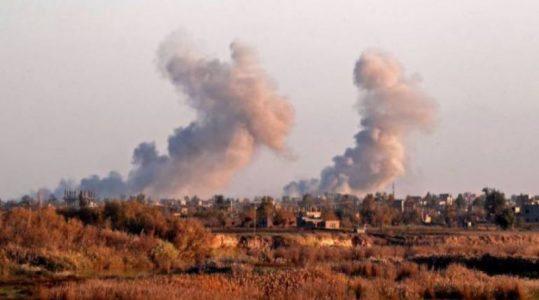
Clashes intensify between ISIS and US-backed forces in Deir Ezzor
Clashes intensify Thursday between Kurdish-led forces and Daesh (ISIS) near Hajin town east of Deir Ezzor province, activists said.
The US-backed group made fresh gains over the week against jihadists defending their eastern Syria stronghold, according to activist Imad al-Obeid.
The Syrian Democratic Forces, with aerial support from the US-led coalition, closed in on the two main spots where jihadists are digging their heels in, the Syrian Observatory for Human Rights said.
Activists said the US-led warplanes conducted more than 143 raids on last Dash pockets near the Iraqi border.
“There is currently fighting around the villages of Al-Shaafa and Sousa,” said Rami Abdel Rahman, head of the Britain-based monitor.
The two villages are the main hubs in what is left of the Islamic State group’s last pocket in the Euphrates River valley, near the Iraqi border.
“The latest developments are in favour of the SDF and it appears the Islamic State may collapse soon,” Abdel Rahman said.
An SDF spokesman, Kino Gabriel, said the Kurdish-Arab alliance was able to repulse several jihadist attacks and was now advancing from three different directions.
A few hundred holdout fighters are defending the last rump of the jihadist organisation’s self-proclaimed “caliphate”, which once covered territory the size of Britain.
The SDF reported in a statement on Sunday that it had evacuated 1,000 civilians from the area where the fighting was taking place.
The Observatory said a total of more than 5,000 people were able to flee the IS pocket since the SDF took Hajin, which had been the main hub in the jihadist’s Euphrates pocket, on December 14.
Abdel Rahman said most of them were women and children but he added that some fighters were trying to blend in with civilians, forcing the SDF to screen the evacuees at the Omar oil field.
The fall of Al-Shaafa and Sousa will cap a years-long multi-national effort to smash the sprawling pro-state IS declared over parts of Syria and Iraq in 2014.
If the jihadists lose these two villages, they will no longer control any populated areas in Iraq or Syria and will have fully reverted to being a clandestine group hiding in desert areas.
Also in eastern Syria, 14 bodies have been exhumed from Panorama mass graves near the city of Raqqa, once the capital Daesh’s (ISIS) self-styled caliphate, Kurdish-run news site reported Thursday.
Raqqa was liberated in a U.S.-backed campaign that ended more than a year ago, but rescuers and recovery teams continue to locate mass graves around Raqqa.
More than two months after digging began in the Panorama mass grave, forensic teams continue to lift bodies believed to have been buried there during the four-month campaign to liberate Raqqa.
Since November, that 760 bodies had been exhumed from Panorama mass grave as estimates put the number of bodies buried there at around 1,500.
Since the fall of Raqqa in October 2017, the local organizations and civil community have been working to rehabilitate and reconstruct the city.
So far, 2,600 bodies have been exhumed from mass graves in the areas of Al-Rasheed Stadium, the zoo, Bedouin Neighborhood, and Ancient Mosque, Al-Arian told a local radio station, according to The Initial Response Team in Raqqa.
Last April, Raqqa’s local council transferred two mass graves containing 500 bodies of civilians and Islamic State jihadists out of the city.
Abdul Aziz al-Metleq, Raqqa-based activist, said victims of the mass graves victims were not only killed by Daesh, but also by the US-led Coalition airstrikes and the YPG-led Syrian Democratic Forces.
The regime forces also has found a mass graves near Tabqa air base, containing bodies of 60 troops killed by Daesh in 2014. The bodied have been moved to Aleppo military hospital.
The SDF has been the main partner of the U.S.-led coalition against Islamic State in Syria, helping drive the jihadists out of swathes of northern and eastern Syria last year.
Since the Syrian revolution erupted in 2011, more than 560,000 people have been killed, and more than 6 million people have been displaced.
Source: Zamanalwsl





